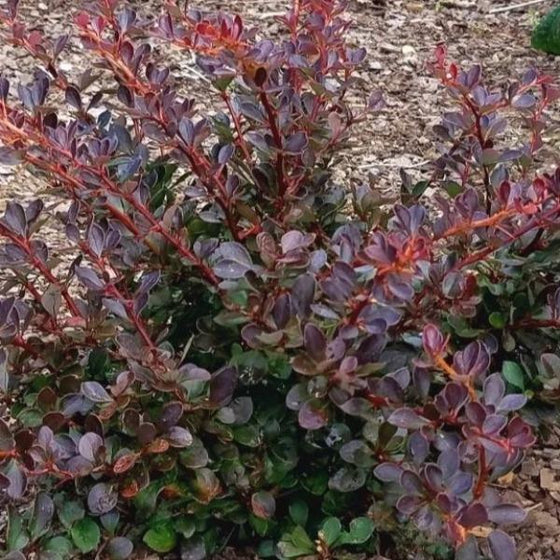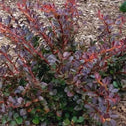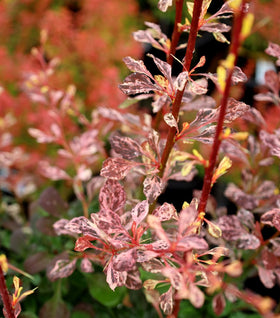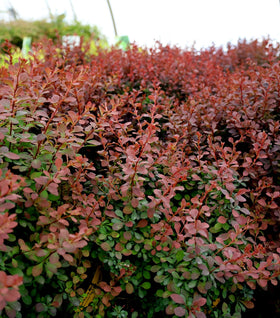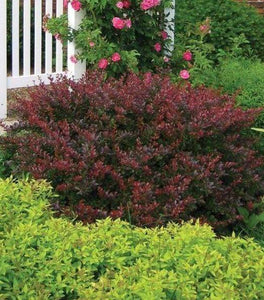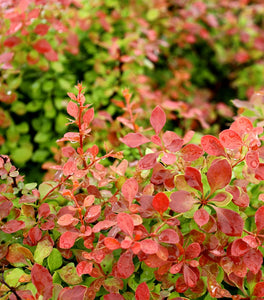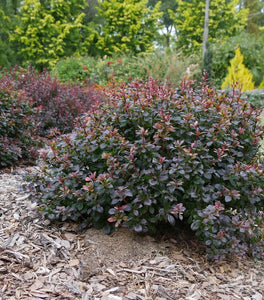Images Depict Mature Plants
Worryfree® Crimson Cutie® Japanese Barberry for Sale Online
The Crimson Cutie® Barberry Shrubs are one of two varieties bred by the University of Connecticut to be truly and completely sterile and therefore a non-invasive Barberry. Japanese barberry bushes became popular in US landscaping in the 1980s and 1990s, but many were found to spread voraciously and crowd out native shrubs in forests.
Now, and after years of careful breeding and testing, you can enjoy the glamorous burgundy look of a crimson barberry bush without worrying about any environmental impact. The Crimson Cutie® is meant to be a non-invasive sterile alternative to the Crimson Pygmy Barberry. Its compact, rounded growing habit makes it ideal for borders, low hedges, and foundation plants.
| Hardiness Zone: | 4-9 |
|---|---|
| Mature Height: | 2 to 2.5 Feet |
| Mature Width: | 3 to 4 Feet |
| Classification: | Broad-leaved deciduous shrub, sterile |
| Sunlight: | Full sun to part shade |
| Habit: | Rounded mounding habit |
| Foliage: | Burgundy-red |
| Flower Color: | Inconspicuous |
| Pruning Season: | Best pruned in late winter before new growth emerges to maintain shape |
| Soil Condition: | Any well drained soil |
| Water Requirements: | Water well until established, then drought tolerant |
| Uses: | Full sun brings out the best foliage color, sterile alternative barberry |
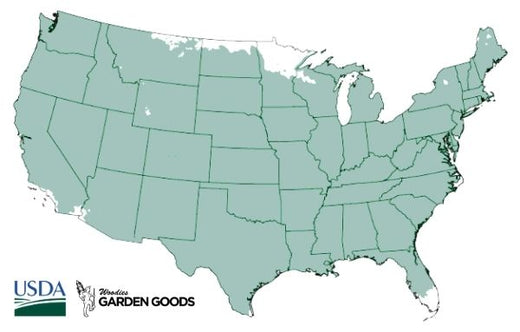
How to Care for Crimson Cutie Barberry
When purchasing your WorryFree Crimson Cutie Barberry, be sure to read the recommended care instructions to ensure a healthy and thriving shrub.
How do I plant my Crimson Cutie Barberry?
We suggest when planting your newly purchased Barberry Crimson Cutie Shrubs that you dig a hole twice as wide as the root system but not deeper. A good rule is that you should still be able to see the soil the plant was grown in after back-filling the hole. Depending on the quality of your existing soil you may need to add a locally sourced compost or topsoil to the back-fill soil. We do not recommend using straight topsoil or compost as a back-fill soil to avoid root rot. Adding compost or topsoil will help the young feeder roots of Barberry Crimson Cutie to spread through the loose, nutrient rich soil.
How do I water cRIMSON cUTIE Barberry Shrubs?
Watering your Worry Free Crimson Cutie is very important while it is still establishing itself in its new home. Give it a thorough soak when first planting, then check your plant every other day for the first few weeks. For each watering, we recommend counting to 5 for each gallon size. A 3 gallon pot would need a 15 count while watering, a 5 gallon pot a 25 second count, etc. This takes much of the estimation out of the equation and will make watering go by faster if you have a lot of Crimson Cutie Barberries planted together in a hedge or mass planting layout. Once established, your barberry will be relatively drought tolerant. If you are not sure if you need to water your plant, it is usually wise to lean towards less than more, unless you are in an especially hot climate in the height of summer.

What kind of sun exposure do Worryfree Barberry Crimson Cuties need?
WorryFree Crimson Cutie Barberries display a rich, deep purple red in the late summer and fall seasons. This color will develop best when planted in a bright full sun spot. It will tolerate partial shade once established, but the color will not be quite as rich when it transitions from its spring green colors.
How do I mulch Barberry Crimson Cutie?
A 2 to 3 inch layer of mulch around the base of your barberries will help to regulate soil temperatures, retain some moisture, and stop weeds from stealing nutrients and resources. Ground hardwood mulch or cypress mulch will provide the best nutrients once it breaks down, but any organic mulch will do the trick, depending on your local availability. Position the mulch so that it creates a donut mound around the shrub under its dripline, leaving a 1 to 2 inch space around the stem of the plant.
Additional Information
WorryFree® Crimson Cutie® Barberry Shrub
This well-behaved shrub is both beautiful and beneficial to our native ecosystems, making it a top choice for gardeners everywhere. Crimson Cutie® is one of two sterile, non-invasive Japanese barberry shrubs developed as a part of the WorryFree® Collection. The other is the Lemon Glow® Japanese Barberry, and these two plants make a handsome pair alternating in a border or foundation hedge with their contrasting colors.
These barberry shrubs grow in a naturally compact, mounded habit, so they require very little pruning or shaping. The vibrant purple-red burgundy color that shines in the summer and fall make these perfect in many circumstances, from focal point specimen shrubs in smaller gardens to foundation planting or a low formal hedge. They would also make a beautiful border around a larger landscaping project in a front or backyard. They love full sun but will be just fine in partial shade as well, although not as vibrant in color.
Crimson Cutie Barberry Shrubs are considered to be a durable shrub, adaptable to a range of soil conditions or climates. They are hardy from USDA zones 4 all the way to 9, and they are deer resistant as well. Once they are established, WorryFree Crimson Cuties are fairly low maintenance, only needing light shaping. They really only need fertilizer once a year, in late winter / early spring before new spring growth commences. While many barberries should have their flowers removed before they can spread seeds, you do not need to worry about Crimson Cuties: they are completely sterile and will not proliferate at all.
Having a non-invasise Japanese barberry is critical to hep protect our native ecosystems. Japanese barberries typically are very prolific in their ability to propagate, since the seeds are a very delicious treat for local birds. The birds digest the seeds and later deposit them far and wide. Once established, a Japanese barberry group can spread like wildfire, and they compete with and overpower the vital native shrubs that local wildlife look to for food and shelter. This is where the importance of a sterile barberry like the Crimson Cutie comes in. These barberry bushes do not create a seed after they have flowered, so there is no seed for birds to eat and spread. This sterile fruit system took a very long for the University of Connecticut to develop and test, but they wanted to be sure that the Crimson Cutie and Lemon Glow barberries were truly non-invasive.
Enjoy WorryFree Crimson Cutie Barberry Shrubs in spring with their fragrant flowers and green foliage all the way through summer and fall with their iconic deep red foliage. These are a great choice for gardeners who want to protect their native landscapes.


